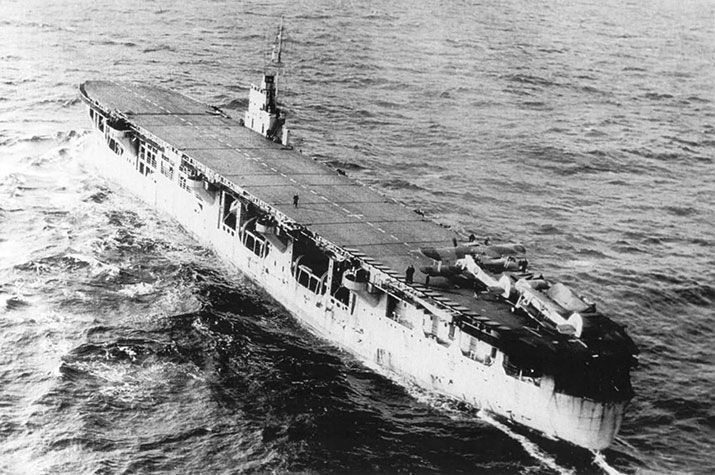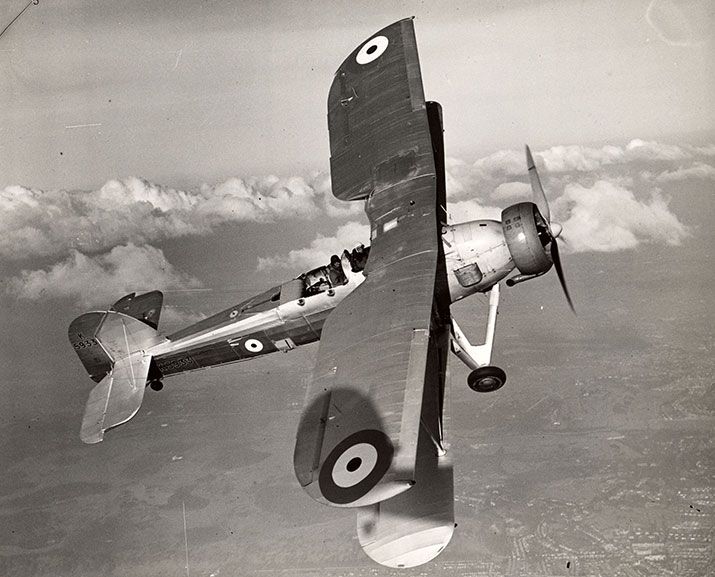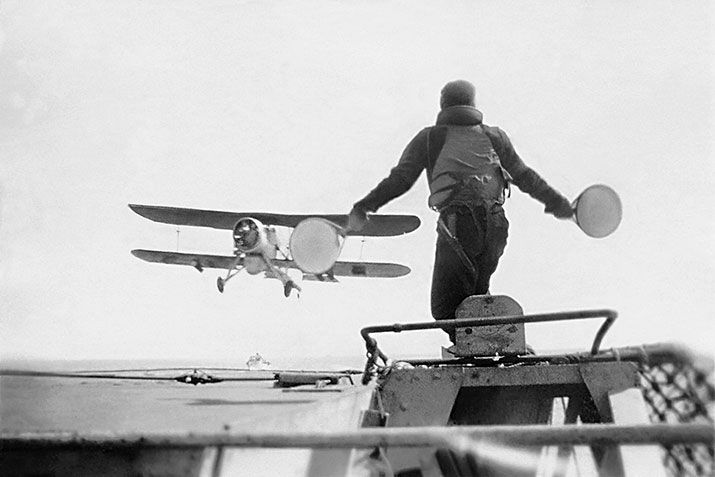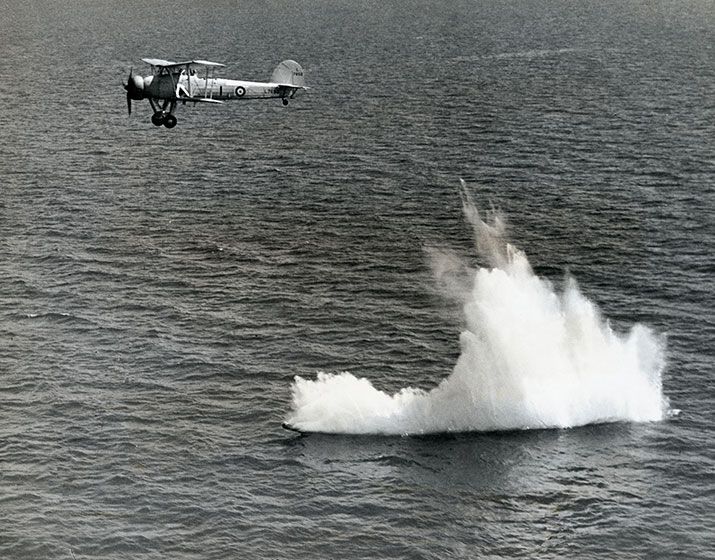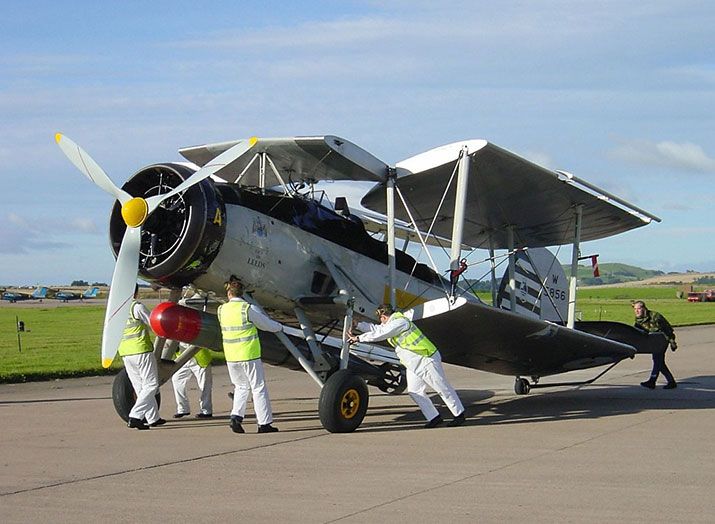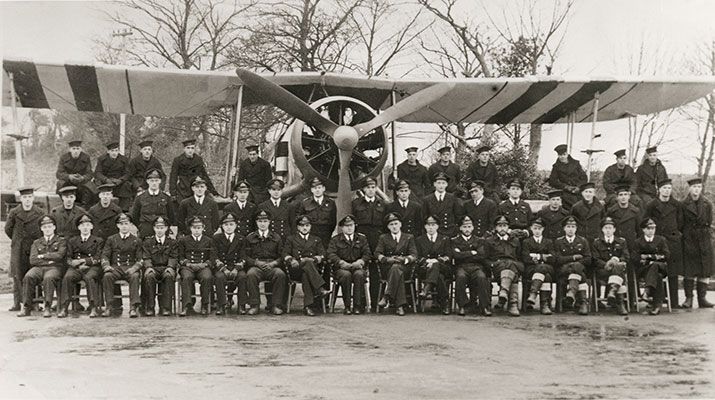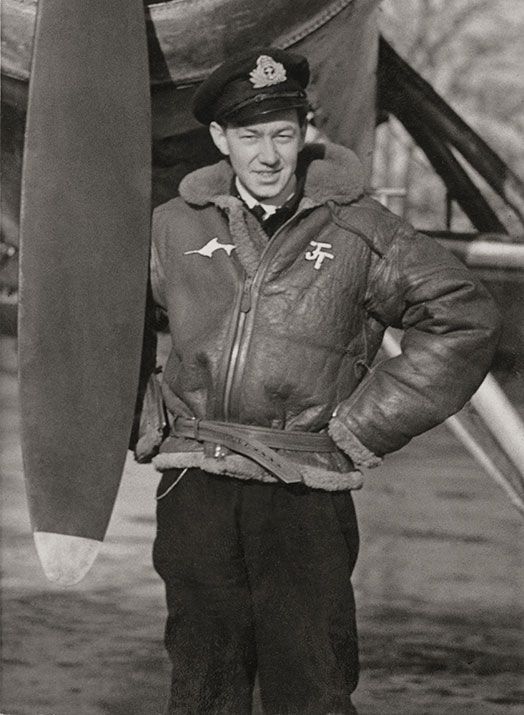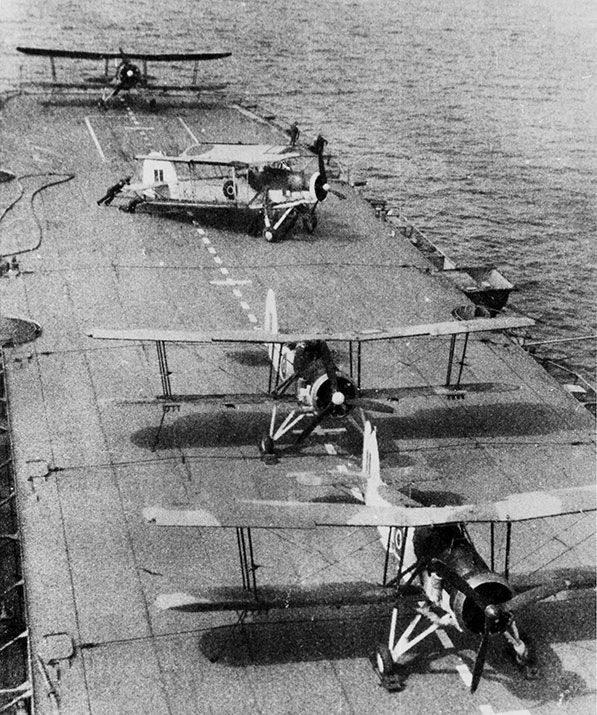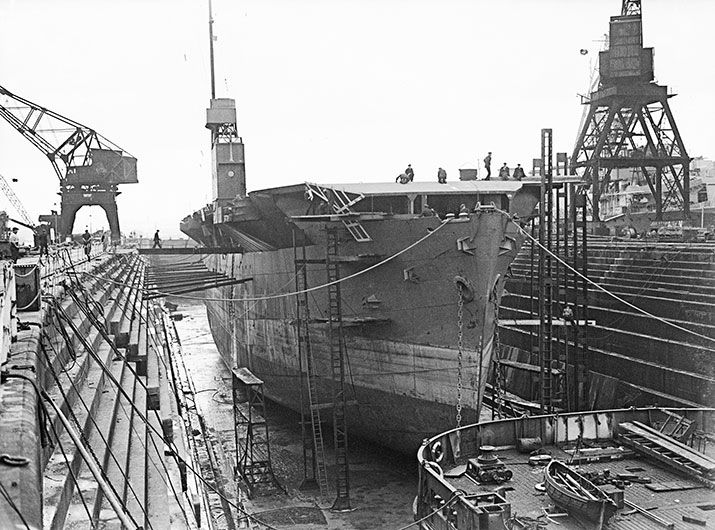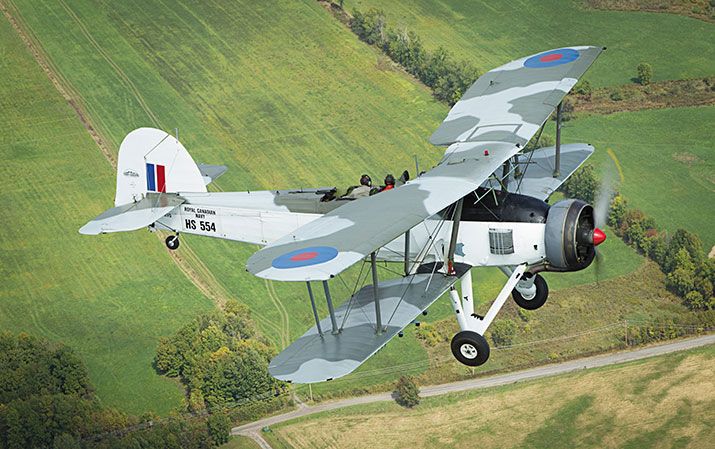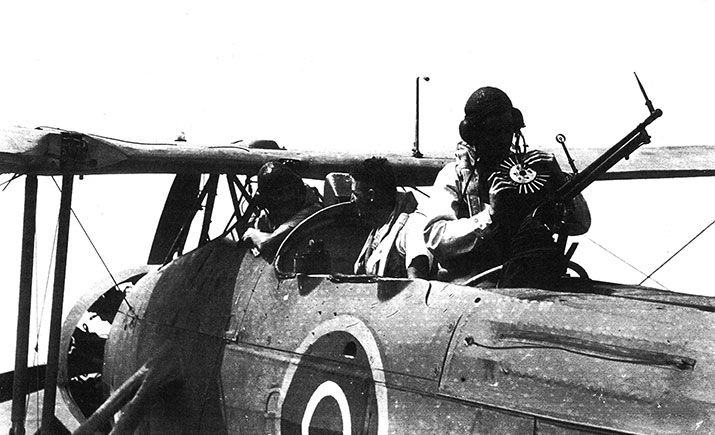Britain’s Desperate Response to U-Boats
Short decks and Swordfish
/https://tf-cmsv2-smithsonianmag-media.s3.amazonaws.com/filer/Shortdecks-Swordfish-Powell-631.jpg)
Barely two hours after Great Britain declared war on Germany at the start of World War II, a U-boat torpedoed the British ocean liner SS Athenia, killing more than 60 of the 1,500 aboard and beginning the long, harrowing Battle of the Atlantic. From that sinking on September 3, 1939, until three weeks before the German surrender in May 1945, the U-boats struck. The worst year was 1942, when more than 1,000 Allied ships were lost, along with their cargoes of fuel, food, and materiel on which Britain depended for survival.
The British had a shocking answer to the submarine menace: a 1934 open-cockpit biplane with fixed landing gear and a cruise speed of around 100 mph. The bigger shock: It worked.
The Fairey Swordfish prototype bore the initials TSR for torpedo, spotter, reconnaissance. It had a crew of three: pilot, observer (navigator), and telegraphist–air gunner. A load hauler for the time, it could carry a 1,600-pound torpedo or 1,500 pounds of depth charges, rockets, or mines. So various were the stores loaded on the airplane that it got the nickname “Stringbag” for the British housewife’s shopping sack, which could expand to carry almost anything. But its chief virtue was its easy handling. The landing approach speed of about 65 mph made it ideal for the small carriers from which many had to operate: merchant ships rigged with flight decks, called merchant aircraft carriers, or MACships.
“There was a well-worn jest amongst Swordfish pilots that the enemy had no speed settings on their gunsights as low as the Stringbag’s cruising speed of 90 knots,” writes pilot Charles Lamb in To War in a Stringbag, “and therefore a Swordfish could only be hit by shells aimed at a flight astern. This was an exaggeration, of course, yet there was an element of uneasy truth in the statement.”
The biplane’s sluggishness was beneficial in other circumstances. During his training as a pilot in the Royal Naval Volunteer Reserve, Jack Thomas was practicing a night rocket attack on a dummy U-boat target when the engine on his Swordfish failed. At an altitude of 1,000 feet over a dark English bay, he shouted, “The engine’s stopped!” to which his new observer replied, “That’s your department.”
It was a moonless, starlit night and the sea could just be seen as a dark shining surface. Thomas slowed and tried to ditch as close to the shore as possible. His observer had started to say they had 300 feet to go, when they hit the water—all one-half inch of it. The wheels ripped off, then the wings in a cloud of spray and mud. The rest of the Swordfish slid for 200 feet before coming to a halt in the wet sand of a tidal flat. Realizing they were safe, the crew broke into a fit of giggling.
Landing a Swordfish on a MACship in the Atlantic could be almost as violent an experience, with every trap accompanied by the same sense of giddy relief.
In his book Achtung! Swordfish! Stanley Brand recalls his experience as a sub-lieutenant in the Royal Naval Volunteer Reserve. On patrol to find stragglers that had become lost during a storm so he could lead them back to the convoy, he had been flying for three hours—the final one spent struggling against gale-force winds to get back to his ship. In the open cockpit of the Swordfish, Brand was numb with cold and fatigue. As he flew closer to his small carrier, he could see the batsman, or deck landing control officer, on his tiny platform with his arms raised, disks in his hands, ready to signal him aboard. The ship was pitching and rolling in the heavy Atlantic swells. It would take all of the batsman’s skills, all of Brand’s flying ability, and a dose of good luck to land safely.
Timing was everything. The aircraft had to be descending steadily to arrive as the stern of the ship was sinking to about three feet above the ship’s lowest point. There was usually a steady moment at the lowest point before the stern started to rise again; it was then that the “cut” signal was given: Pull the engine to idle and drop the nose. The uphill slope of the deck helped bring the aircraft to a halt and reduced the load on the arrester wire. It would have been very difficult at this point to go around because the Swordfish was at its lowest, and obstructions forward were highest. The ship’s roll also had to be considered. The best touchdown coincided with the middle of a roll from starboard to port so that the left side was going down and an escape route free from obstruction—except for the batsman on his platform—was available to the pilot who could swing violently left over the side of the ship, gun it, and with luck stay airborne.
Brand landed safely. Months later, his aircraft emerged from heavy fog just in time for him to see his ship and, in the same instant, the batsman waving him off. With no time to react, he bore down on the batsman, who hurled himself over the side to land in the safety net, hanging just below his station. More than one batsman had to leap for the net, according to pilot John Beresford. The Swordfish’s radar antenna hung from the lower wingtip, “like a carving knife about 18 inches long,” he says. “You couldn’t duck if it came too close. You had to jump into the net.”
Unlike American landing signal officers, DLCOs were responsible for aircraft launching, refueling, and overall flight deck discipline. Sub-Lieutenant Jack Thomas flew the Swordfish from November 1943 to February 1945, when he was ordered to train as a batsman. “I wasn’t too pleased at first but found that I had a natural ability and really began to enjoy the job,” he recalled in a recent e-mail. In order to make himself more visible to the pilots, Thomas created a new “batting rig” of a red rugby shirt, a blue and white cap, and a fluorescent disk on his chest.
Batsmen were not permitted to fly although they were pilots; some, in fact, had so many hours flying in combat that they suffered from battle fatigue. “Often the best DLCO’s were pilots of long flying experience who developed a nervous disposition because of stress caused by over-exposure to dangerous activity without relief,” Stanley Brand wrote in notes for a series of lectures he gave on his Royal Navy experience. “Unlike the RAF which gave seven days leave every eight weeks to operational aircrew with a second-line posting after 30 operational flights, the Fleet Air Arm had insufficient manpower, or willpower, to adopt a similar policy.
“Men of great experience, living on their nerves but with the courage to carry on in spite of their misgivings were ideal subjects to become DLCOs and an inappropriate comment sometimes made by the insensitive was ‘He may be a new DLCO, but it is obvious that he has been bats for ages.’ ”
So dire was the supply shortage in 1942 that the British had no time to wait for escort carriers to be built from the keel up. Instead, the admiralty directed ship makers to transform oil tankers and grain haulers into carriers by building flight decks atop them. These types of ships were selected because of their size and because oil and grain were both pumped on and off instead of being lowered by crane into a hold. The MACships could continue to carry grain and oil while operating aircraft. Nineteen MACships went into service between April 1943 and April 1944 and operated throughout the war. Thirteen were tankers weighing 8,000 tons and having flight decks 460 feet long. Six were grain ships whose decks were 40 feet shorter.
Grain-carrying MACs had a hangar below the flight deck into which airplanes could be lowered for storage and maintenance, but the tanker MACs did not. On an oiler MACship, when one aircraft was landing, the other had to be moved forward of the barrier abeam the island, the ship’s command center. All maintenance had to be done on deck as well. Since convoys were routed as far north as possible, there was only four hours of daylight much of the year. The only lights permitted on deck were flashlights, and those had cardboard over the lamps, with quarter-inch holes for light to shine through. In his lecture notes, Stanley Brand wrote, “Refueling, rearming, and correction of electrical and mechanical defects had to be carried out largely by feel.”
Both ships were narrow, a mere 62 feet wide. The Swordfish’s wings, with a span of 45 feet, were eight feet from the deck edges—when the aircraft was on the centerline—except beside the island where the clearance was only 27 inches. MACships were poor sea-keepers. They “rolled like a pig with waves from abeam,” wrote Brand, due to the weight, much of it 30 feet above the waterline, added during conversion.
A mix of Merchant and Royal Navy personnel set to sea on a MACship. The captain (who had been through a rushed, two-week training course) and ship’s crew were civilian. The aviation detachment, which came from 836 Squadron, based at Maydown in Northern Ireland, typically consisted of four Royal Navy pilots, four observers, and a DLCO—all commissioned officers. Enlisted men included four telegraphist–air gunners, a chief petty officer in charge of maintenance, two fitters (for engines), two riggers (for airframes), one electrician, and a radio-and-radar technician. Flight operations with three or four Swordfish were run by an air staff officer, usually an observer with the rank of lieutenant commander.
The Swordfish telegraphist–air gunner, or TAG, monitored Morse code coming in on the radio. He was not allowed to transmit except in an emergency or when in contact with the enemy. Royal Navy rules prevented him, as an enlisted man, from associating with officers—including during flight briefings. He met with his pilot and observer only at the airplane.
According to Jack Thomas, the Swordfishes were sent to patrol various areas, based on intelligence received by the commodore of the convoy. Encrypted radio messages between U-boats and their command centers, intercepted and decoded by British technicians, gave away the positions of the submarines. “The successful use of aircraft patrols was not only to sink the U‑boats,” Thomas adds, “but to deter them by keeping them submerged, where they were slower than the convoy—a case of preventative medicine.”
On sub patrols, each crewman watched a section of the ocean, says John Beresford, who served aboard both escort carriers and MACships. “The observer and rear gunner had binoculars,” he says. “Most U-boats cruised just below the surface in daylight, with the periscope leaving a small trail, the size of the trail depending on the sub’s speed. If the plane was reasonably low—say, 500 feet—you could see the periscope and the feathering trail that it left. And if the water was reasonably calm, you could see the hull just below the surface. If they were more than about 20 feet below the surface, or if the sea was very choppy, they couldn’t be seen.
“The U-boats had to come to the surface for speed and oxygen. They could travel twice as fast—about 10 knots—on the surface, but only about 5 knots submerged. Once they knew that they had been spotted, they could decide either to fight it out on the surface or dive to a safe depth.”
On a March 1944 patrol, just before Beresford’s 21st birthday, the U-boat captain decided to fight it out. Beresford had taken off from the U.S.-built escort carrier HMS Chaser, part of a convoy returning from delivering supplies to the Soviet port Murmansk. “There was broken cloud at about 500 feet, very low but it would be good cover if and when we met a U-boat,” he recalls. When his air gunner spotted the submarine several miles away, Beresford immediately climbed into the cloud. He was carrying eight armor-piercing rockets under each wing. “We flew in cloud as close to the U-boat as we could, then dived on him,” Beresford says. The U-boat opened up on Beresford with four 20-mm cannon, and Beresford fired the rockets. “I don’t know how many hit him, but he started going round in circles so I presume his steering gear was out of action.” When the U-boat started sinking, Beresford’s TAG radioed a convoy frigate, which came to the rescue, and Beresford returned to the Chaser and landed with five minutes’ worth of fuel left. He and his crew were lifted from the cockpits by pulleys rigged on a scaffold to hoist them out after winter missions in the open cockpit had left them too cold and stiff to climb out on their own. Frostbite was a frequent problem.
MACships were popular with the air crews because they went straight across the Atlantic in about three weeks with the same convoy, then spent four to six days in port loading and unloading cargo before heading out again. In contrast to wartime England, with its shortages, life ashore in Canada was luxurious, with plenty to eat and drink. Everyone shopped for items scarce back home, and aircrews had an advantage: They could load their Swordfish with goodies—chocolate, nylons, canned fruit, sugar, booze—which they flew ashore at the end of the journey. The Stringbag earned its sobriquet by carrying these treats instead of ordnance; some bulky items, including more than one bicycle, were strapped to bomb racks or wing struts. The laden airplane would land at home field, be taxied into a hangar, and unloaded before His Majesty’s customs inspectors were called.
When the Mark III version of the Swordfish came into use, the gunner’s position was eliminated in order to make room for the air-to-surface-vessel radar. In that version of the biplane, the ASV radar scope and controls went into the rear cockpit, where the observer worked them in addition to serving as telegraphist and navigator.
Working in an open cockpit required a set of rare skills. In Achtung! Swordfish! Stanley Brand describes the challenges of an observer’s job: “It was indeed a miracle that an observer could concentrate on the difficult task of keeping track of our whereabouts with a chart and chart board balanced on his knee, without a table for his instruments, needing pencils, ruler, rubber, dividers, compasses, records of deviations, variations, courses and times flown, wind speeds and direction and a calculator for drift and distance flown. Gloved hands and sometimes numb fingers made it difficult to hold these awkward things and if they were dropped Sod’s Law decreed that they would rest just out of reach, with movement restricted in the confines of the cockpit and by the many layers of clumsy protective clothing. There was a limit on the number of bits of string which could be used to restrain individual items of equipment such as eraser, ruler, pencil and protractor without creating a spider’s web when in use.”
The Swordfish is best known for three actions unrelated to Atlantic convoys: launching the torpedo that crippled the Bismarck and led to its destruction; a doomed 1942 strike on German ships during the famous Channel Dash (all six aircraft were lost), and the historic Battle of Taranto—a night attack that took out half the Italian battle fleet. But the biplane’s chief contribution was made from the decks of MACships. On April 18, 1945, a U-boat using new acoustic homing torpedoes, which enabled it to fire without extending its periscope, sank an ammunition ship and a tanker, both in Jack Thomas’ convoy. They were the only ships sunk in more than 200 convoys that had been escorted by MACships since May 1943. The Battle of the Atlantic was not won by MACships, but if they had been introduced earlier, many more Allied ships would have been saved.
Robert R. “Boom” Powell was a Navy aviator and airline pilot before writing about aviation history and flying gliders and antique aircraft.
